Seeing "War and Peace" in 70mm is so rare. It is like a very fine wine. You
HAVE to appreciate it |
Read more at in70mm.com The 70mm Newsletter |
| Written by: Jan-Hein Bal (NL), Thomas Hauerslev (DK), Mark Lyndon (UK), Gerwin van der Pol (NL), Johan Wolthuis (NL) | Date: 10.11.2013 |
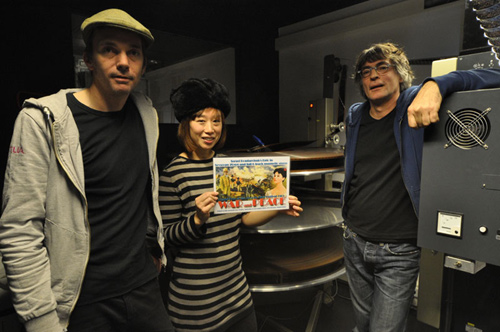 Projection
crew. Kim, Anti and Ron Salari. The film can be seen behind them on the platters
- all ready to go. Projection
crew. Kim, Anti and Ron Salari. The film can be seen behind them on the platters
- all ready to go.I am not a "War and Peace" virgin any longer. I have now seen it, as it was meant to be seen - in 70mm in a cinema. "War and Peace" has been on top of my 70mm wish list almost since my interest in 70mm emerged some 35 odd years ago. I have never been able to catch a screening of this monumental film. Many times have I tried program it for the Widescreen Weekend, but my friend and fellow programmer Bill Lawrence was never too keen on the idea, so - sadly - it went nowhere. My Danish friend Orla Nielsen have spoken enthusiastically about "War and Peace" for 25 years. He once showed it in his cinema in 1982 and was very moved by the film, especially by the visual language, like the flying cameras, things falling down in front of the lenses and POV shots of cannon balls etc. The Danish 70mm print was in very good condition, in glorious ORWO colour, full length and complete. By 2001 the Danish Film Museum, which had an entire library of Russian 70mm titles, exported the lot, including "War and Peace" to the Norwegian Film Institute. The Norwegians have now stored "our" 70mm prints in Troll caves far north of the Arctic Circle and made them completely inaccessible, claiming "War" to be too fragile to show any longer. That is bullocks and a shame. They should all be returned to Denmark where they belong. |
More in 70mm reading: "War and Peace" in Amsterdam 9. November 2013 Sovscope 70 Amsterdam 70mm Cinema History |
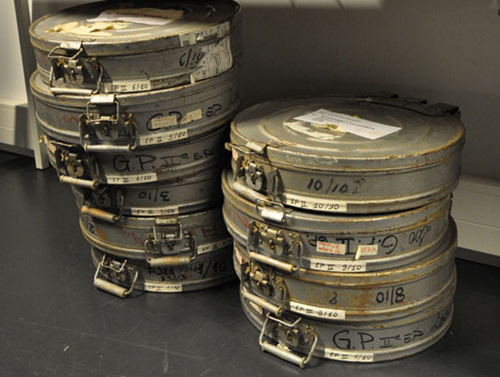 Russian
transportation cans for 70mm - they look like ammunition cans. "War and
Peace" fits into 20 cans like this. Russian
transportation cans for 70mm - they look like ammunition cans. "War and
Peace" fits into 20 cans like this.In October Jan-Hein Bal wrote me an e-mail with the news about the EYE screening, and I jumped at the opportunity to travel all the way to Amsterdam and back, simply to see Sergei Bondarchuk's "War and Peace" in 70mm. Despite warnings about the print condition, wear and tear and shorter running time, I never hesitated to go. This was it, my window of opportunity to see it. I met Jan-Hein and Mark Lyndon at the EYE at 11, but before the film we went upstairs to the projection room to meet the trio of projectionists who were in charge of this show. The projection team had tested the film earlier this week, and said it had shrunk a bit, so the sound was not the best, but it would work. What happens is this, when a 70mm shrinks (and become 69mm or less) the magnetic stripes does not align perfectly with the magnetic sound head in the projector, and therefore, it can be difficult to maintain perfect play back when the 70mm print goes through the projector. The entire film had been assembled on platters in two large 3-hour chunks. An impressive sight to behold, and while the Kinoton FP75E machine was ready to "rock and roll", we took our seats on row 4 slightly off center. |
Gerhard Witte (Berlin) have supplied more
details about Mosfilm's "War and Peace" The film was shown in West-Germany in 3 parts: Part 1 "Petersburg Tanzt" 165 Min (1967) Part 2 "1812 - Napoleon vor Moskau" 95 Min (1968) Part 3 "Moskau brennt" 77 Min (1968) Total running time 337 minutes In East-Germany the film ran in 4 parts (slightly shortened with a total running time of 409 minutes - the original runs 432 minutes) |
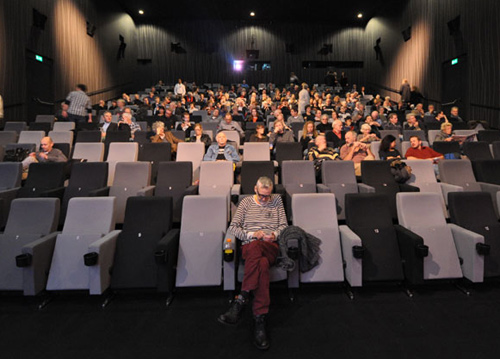 "War
and Peace" audience minutes before the show begins. "War
and Peace" audience minutes before the show begins.The 70mm screening started at 12 o'clock and was introduced in Dutch by Professor Gerwin van der Pol. Gerwin had kindly made a short English summery of his intro for Mark Lyndon (from London) and me. Like myself, Mark travelled a long way to join me for this screening. A big thank you to Gerwin for making the summery. Around 175 people was in Screen 1 that morning with us. I firmly believe this OSCAR winning film deserves to be screened from time to time on a big screen in 70mm. And the crowd this morning proves my point. Show it in 70mm, and people will come. The film began around 12:30, and before we knew it, the intermission came 3 hours later at 15:30. A short "intermission" title card around 2 o'clock gave away the fact, that our part one, was actually part 1 and part 2 of the film. After a 30 min break, "War" continued at 4 o'clock, and ran until ten minutes before 7 o'clock. Around 17:23 another "intermission" title card signalled the end of part 3 and the beginning of part 4. This print was the slightly shorter 337 minutes (5 hours and 37 minutes) version of the original 432 minutes (7 hours 12 min) running time. It was also an original Russian language print, with French and Dutch subtitles - none of which I can understand or read particularly well. |
I have the really rare US LP Score Album of
the film in a gatefold cover from Capitol/Melodiya. The score was composed
by Vyacheslav Ovchinnikov.
The production notes are interesting: “For its American premiere run, commencing Sunday, April 28, 1968, at the DeMille Theatre in New York City, the seven-hour-film was divided into two parts, each to be screened at a separate performance on successive evenings. A single ticket, priced at $5.50 to $7.50, entitled the purchaser to attend both performances.” |
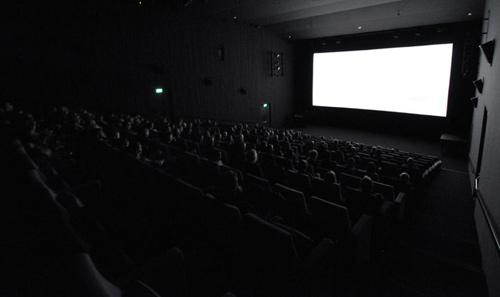 Slightly
curved 70mm screen. Slightly
curved 70mm screen.A short 70mm trailer appeared before part two began. The trailer explained what had happened in part one, should anyone have missed it. Jan-Hein explained to me it was not a trailer, but it was a short intro for the audience who had seen part one, maybe several months before seeing part two, during the original release. It makes sense. The "This week on War and Peace" trailer also revealed some scenes which we didn't see in part one. They had been cut for this European release version of the film. "War and Peace" is a very long film, and the story is massive to say the least. It is very hard to take all this in, in 7 hours, and I need to digest this story in the coming years. I had read a little bit about the story, but I need to go back to broaden my horizon about what was going on. I picked up some of the subtitles, because Dutch and Danish - despite being totally different orally - some words are similar here and there. And as it was subtitled in French too, I did understand fragments of the story, but still, I am unable to tell what was going on, except in very broad terms. But never mind that, I look forward to explore that in the years to come. |
|
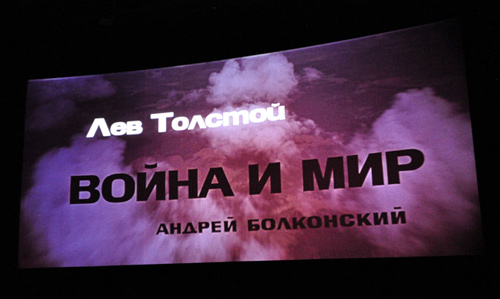 "War
and Peace" title card in Russian. "War
and Peace" title card in Russian.The presentation was a marvel to behold. The three projectionists did a fantastic job keeping the film in focus and steady throughout the performance. Thank you guys! ORWO color prints are not easy to work with compared to Eastman prints. Every time a join (a splice) goes through the machine, it makes a large "CLAP", or "CLICK", and you have to be on your toes to adjust the focus or pressure bands if the picture jumps. As mentioned before, the soundtracks played tricks here and there. From my seat, slightly off to the right, the right speaker was dominating throughout, but the soundtrack in general was discrete, and moved from speaker to speaker. Scratches, changeover marks, splices, tape hiss and some dropouts was present all the way through, but I would not expect anything less from an old print like that. Despite the museum's warning about the lack of colors, the entire film had fine color. No faded-to-magenta reels, like Eastman color often does. That was a pleasant surprise. |
|
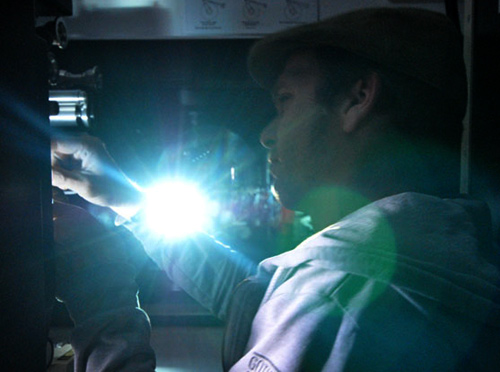 Projectionist
Kim working with "War
and Peace" on his Kinoton FP75E machine. Projectionist
Kim working with "War
and Peace" on his Kinoton FP75E machine.Also adding to the show was the fact, that it was 70mm we were looking at, and three people were actually working upstairs, while we - the audience - were enjoying their skills on the slightly curved screen. An old 70mm print like that, has a life of its own and requires constant care and attention. Imagine how many times it was shown when it came out in 1967/68, and it is still with us! It is a living thing and I think only very few people realize how rare this performance was. As Mark put it later: "Seeing "War and Peace" in 70mm is so rare. It is like a very fine wine. You HAVE to appreciate it". Seeing a classic film in 70mm is a totally different experience compared to the standard of 2013, where nearly everything in cinemas is projected digitally. Digital looks and sounds perfect every time, but it is a very sterile type of performance and it lacks the small hints of human interference, which I think is so desirable when going to the cinema. An example is when the projectionist is working with the focus or adjusting the image up or down. It is nice to know someone is up there making sure you have a good time. A digital version of "War and Peace" would be a flawless "plastic" experience, too easy, or too artificial. It is not the real thing for me. Would you go to the theatre, or the opera, to see a digitally projected performance, which was exactly the same as last night, or the night before? People are part of the show. |
|
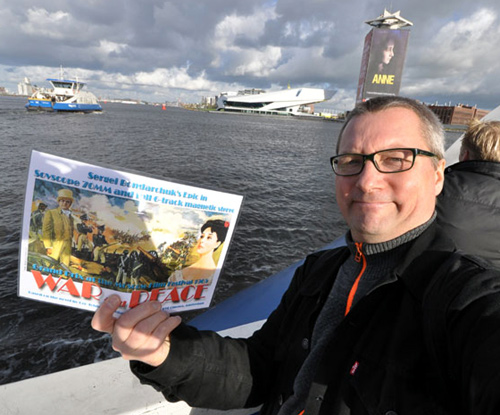 The
editor with the "War and Peace" 70mm
poster and EYE cinema in background. The
editor with the "War and Peace" 70mm
poster and EYE cinema in background.Click on the image to see a large poster. I am very much in favour of digital projection, thanks to the quality, but I will always prefer an old, worn, cut or even completely faded 70mm print over ANY digital performance of the same title, provided a 70mm print is available. Its the feeling of nostalgia to know this print is ORIGINAL, and maybe 40-50 years old, which does it for me. I don't mind if a 70mm print is new and looks good of course, but my point is, I can see any film digitally anywhere and at any time - and even at home! But not 70mm. 70mm is shown by people for people, and can ONLY be enjoyed on very rare occasions in cinemas today. It is the "Splendour" and "Showmanship", which is so very closely linked to 70mm for me. That is the experience I like. Show it in 70mm and they will come. The EYE museum respectfully showed the film in 70mm, and the audience did come, and in greater numbers than expected as I understood. The EYE museum - especially the projectionists - did a wonderful job this day in November 2013. "War and Peace" was a thrill to see in Sovcope 70 and it was surely worth the travel, expense and time for me. |
|
Notes by Mark Lyndon, UK |
|
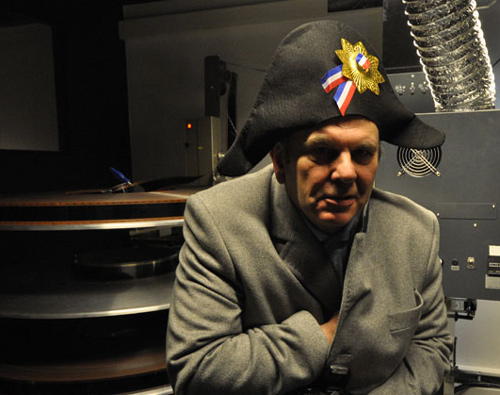 "War
and Peace"'s very own Napoleon visited the projection room.
As you can see, 70mm is also about having fun and create moments. Mark
Lyndon is famous for dressing up like this. "War
and Peace"'s very own Napoleon visited the projection room.
As you can see, 70mm is also about having fun and create moments. Mark
Lyndon is famous for dressing up like this.A truly Tolstoyian, heroic, feat of projectionship was achieved at the Eye Cinematheque in Amsterdam on Saturday November 9th. A miracle was wrought from noon to night. A vintage and venerable 70mm print of that great classic of Russian, indeed, world cinema, Sergei Bondarchuk's War and Peace was screened, successfully, by the Eye's hard working, dedicated and professional cadre of projectionists. Those familiar with Tolstoy's epic novel and the various film and TV versions thereof, are agreed that Bondarchuk's portrayal of Pierre Bezukhov is by far the most convincing and faithful to Tolstoy's conception. It is all the more remarkable that he triumphantly pulled off the Herculean task of directing his towering epic. |
|
 "War
and Peace" discussion after the film in Amsterdam. Left is Johan Wolthuis, Jan-Hein Bal, Wouter de Voogd and Mark Lyndon. "War
and Peace" discussion after the film in Amsterdam. Left is Johan Wolthuis, Jan-Hein Bal, Wouter de Voogd and Mark Lyndon.Seldom using one violent explosion when ten would do, Bondarchuk defiantly ran the risk of inducing battle fatigue in his audience as he relentlessly drove home the Tolstoyan message narrating the horrors of war. Painterly influences from Hieronymous Bosch to Goya permeate and inform the battle sequences and the shattering depiction of the burning of Moscow. Bondarchuk's influences can be discerned in turn, in other war films, such as Kubrick's Full Metal Jacket. Bondarchuk is the great master of POV, skilfully revealing many points of view ranging from cannonball to principal character. Special mention needs to be made of his fellow principals. Liudmila Saveleva gives us a wonderfully nuanced Natasha Rostova, out Hepburning Hepburn herself. Vyacheslav Tikhonov, as prince Andrei Bolkonski, gives a powerful and deeply moving performance as the only man who understands Pierre - through his own terrible sufferings. |
|
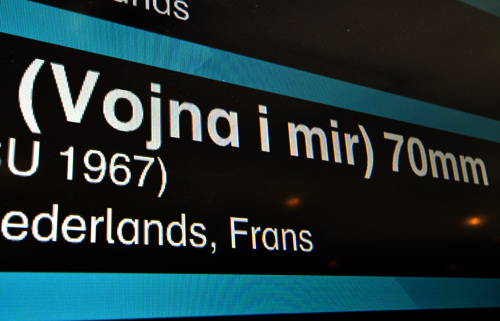 The
only advertisement for the 70mm presentation of "War and Peace" to be found
at the EYE museum. The EYE is designed by an Austrian architect and looks
like a cross between a ski slope and a woman's shoe. It is a striking
building, however, local people tends to agree, it is a disaster as a film
museum - not even allowing the museum to use any exterior sign, following
the architect's specific orders. It sounds too crazy to be true. The
only advertisement for the 70mm presentation of "War and Peace" to be found
at the EYE museum. The EYE is designed by an Austrian architect and looks
like a cross between a ski slope and a woman's shoe. It is a striking
building, however, local people tends to agree, it is a disaster as a film
museum - not even allowing the museum to use any exterior sign, following
the architect's specific orders. It sounds too crazy to be true.Boris Zakhava, is the definitive Marshal Kutuzov. From a military background himself, he participated in the centenary celebrations of the 1812 victory over Napoleon. Zakhava went on to become one of the most distinguished actors and teachers in Russian theatrical history. This glorious masterpiece triumphed and shone brightly through the ravages of the passing years. Those of us who saw it felt very privileged and fortunate to have done so. We now have one important thing less we have to do before we die. |
|
Notes by Jan-Hein Bal, NL |
|
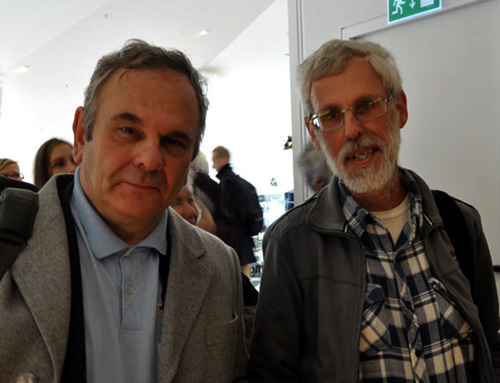 Mark
Lyndon (left) and Jan-Hein Bal. Mark
Lyndon (left) and Jan-Hein Bal.During their Ruskino 1913-2013 filmfestival in the Amsterdam Eye Film Institute I joined a screening of the Soviet "WAR AND PEACE", my fourth viewing but first time in 70mm, a Belgian vintage print in a marathon from 12.00 to 19.00. I was accompanied by others including Thomas Hauerslev after I suggested to include it in his in70mm.com international calendar. This is my main example of a movie which ages well as it improves with every viewing. I first saw a similar abridged version in 1970 in a local 35mm cinema, totally unprepared for such a Soviet movie, heavy, slow, boring, with ugly Sovcolor, terrible music and also a Dutch box office disaster. A bad VHS did not help much but in 2009 I discovered the full Soviet version on a DVD from the Icestorm-label and with a terrific making of it really opened my eyes. A thoughtful, respectful, moving masterpiece, with stunning tracking shots, exciting locations and sets, impressive score and editing, the perfect preparation to enjoy finally a 70mm screening. What a relief to see a serious Napoleon here, after some terrible overacted Hitler caricatures in Soviet movies recently seen (including "FALL OF BERLIN" also in the Ruskino festival). |
|
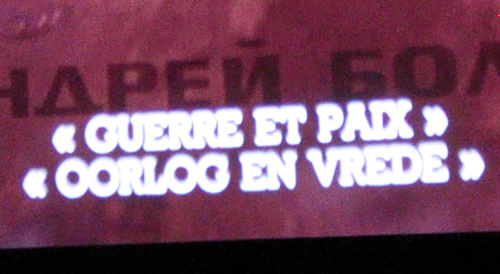 "War
and Peace"'s double line of subtitles - French above and Dutch below. "War
and Peace"'s double line of subtitles - French above and Dutch below.For over 175 visitors Gerwin van der Pol in his introduction stressed the exciting camera movements and impossible task for Bondarchuk, not only directing one of the most complicated movies ever but playing the main part as well. The print was a real job for the projectionists and it was announced that part one of the eighteen reels was faded and part two had troubled sound because of shrinkage which almost caused cancelling everything. But both proved much better than I feared and the print was beyond all my expectations, terrific images with absolutely stunning close-ups. There were some strange uneasy cuts, either by damage or trimming the original full Soviet version into two part for Western release. This time I especially noticed the unusual use of freeze frames and an extreme range of sound volume, from very loud chorals to dialogue which must be almost too soft for any Russians on the back row. Again in a 70mm print I discovered a mistake I never noticed before, here a shadow of the camera dolly during a nightly tracking shot, that’s a difference of a 70mmm print. |
|
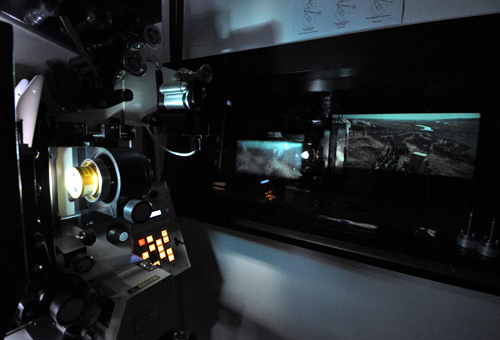 Reflections
of projection. Reflections
of projection.After the only break part two started with a rather clumsy summary of part one, even including shots not seen in part one. The following order was perfect with the faded part one on Eastmancolor stock followed by part two (despite its Belgian origin) on Svema/Orwo stock and the best demonstration of the fact that Eastern European color stock ages better and fades much less than Western stock. What a pity that the Soviets had the world’s largest 70mm production while their countless 70mm vintage prints lie mostly unseen in the Moscow Gosfilmofond archive in delicate condition without funds for restoration. The Berlinale 2009 proved some treasures hidden there like the long suppressed masterpiece "STARS OF THE DAY". I hope my future Soviet 70mm history book Red Widescreen will challenge archives to bring them back to the audience again. |
|
Notes by Johan Wolthuis, NL |
|
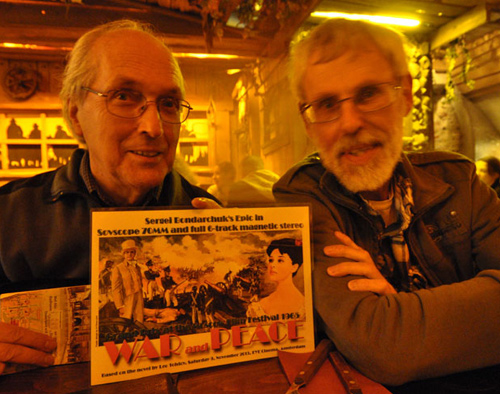 Johan
Wolthuis and Jan-Hein Bal. Johan joined us for the second half of the film
and for dinner in a local Argentinean restaurant called San Thomas. Johan
Wolthuis and Jan-Hein Bal. Johan joined us for the second half of the film
and for dinner in a local Argentinean restaurant called San Thomas.My impression of the 70mm "War And Peace" (I saw only the second part). Nice print from this 1967 movie, not much faded compared with American 70mm movies from that time! This Russian film has many impressive shots and unbelievable mass scenes with thousands of soldiers and inhabitants of Moscow, etc. But I had to do my best not falling asleep because in my opinion the battles and explosions lasted too long and I saw different times the same explosions with a lot of clouds, etc. |
|
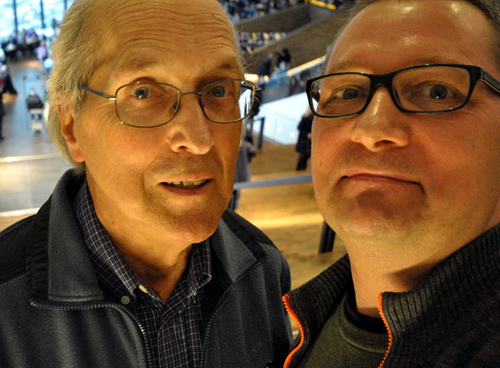 But
I realize that it must have been a gigantic project to make this film of 6
or even more hours. And my compliments for the EYE projection team, no break
down everything went smooth. But
I realize that it must have been a gigantic project to make this film of 6
or even more hours. And my compliments for the EYE projection team, no break
down everything went smooth.But I didn't see the brightness of original 70mm filming except in the ballroom scenes. So my conclusion is: this was not my kind of film! I prefer "Lawrence of Arabia"! But as I said I appreciated more the talks with you, Thomas, Mark and Jan-Hein and the meeting in the Argentina restaurant after the screening. So no regret at all coming to Amsterdam. |
|
Introduction by Gerwin van der Pol, NL |
|
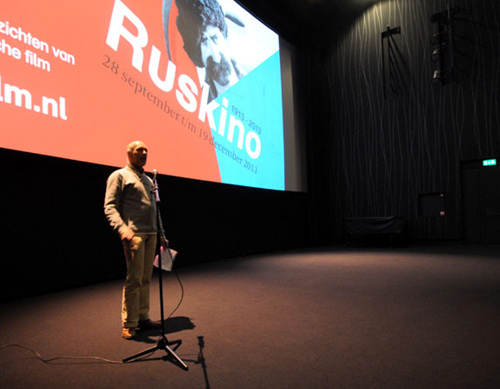 Gerwin
van der Pol Introducing War and Peace, 9 november 2013, Eye, Amsterdam Gerwin
van der Pol Introducing War and Peace, 9 november 2013, Eye, Amsterdam100 years after Russia wrote War and Peace, and 50 years after the Russian Revolution, and 10 years after the detested American King Vidor version, Russia wanted to have the ultimate Russian "War and Peace". Sergei Bondarchuk got the job, because he had just became world famous with his film "Destiny of a Man" (1959), in which he also played the main part, about the horrible fate of soldiers during World War II. The book was written by Sokolov. Bondarchuk got the job instead of the Mikhalkow brothers or Andrei Tarkowski. Tarkowski made instead Andrei Rublyev, as a way to pay tribute to another famous Russian artist. The music to that film is by Vyacheslav Ovchinnikov, written at the time he also wrote the music to "War and Peace", which was difficult enough, as you will hear later on. |
|
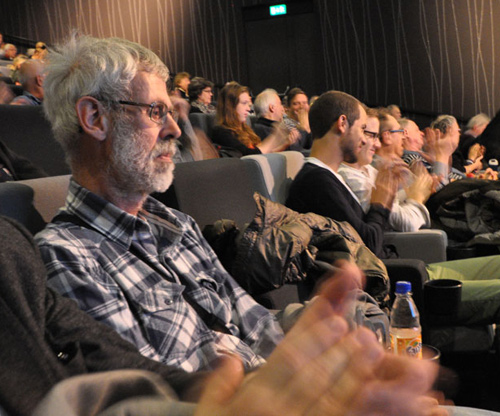 Applause
after the introduction Applause
after the introductionThat is just an example of what is so impressing in this film: everything is big, bigger, biggest. It just had to be in 70mm. And it had to be a very long version. This version is 339 minutes, 100 minutes shorter than the original, but nevertheless the version that was intended for the European market. There was no money issue while making this film: it does everything to show as completely as possible all aspects of war and peace in Russia 1812, fighting against Napoleon. Everything is made on a scale of 1:1. Part of the palace where Natasha Rostov’s (Ludmilla Savesteva) has her first ball, was reconstructed in a studio, at the battles there are many thousands of soldiers. We don’t know exactly how many, 12000 is the best guess. The Russian soldiers had to work for this film: it was just part of their job of defending the honour of Russia against the violence of the American film "War and Peace". The costumes they were wearing were historically accurate. As is every detail in this film: every museum gave their collection to this production. |
|
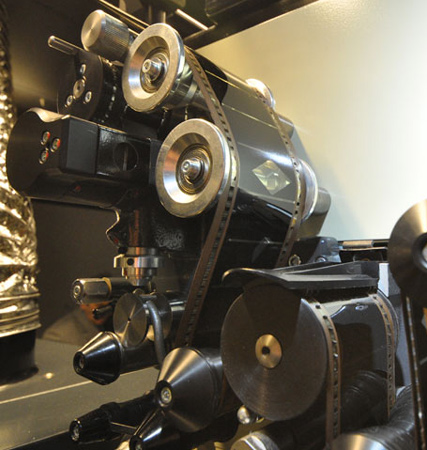 Rollers,
magnetic sound, frame lines, 70mm film and perforations. Rollers,
magnetic sound, frame lines, 70mm film and perforations.But most of all, the film is impressive because of the filming: the camera plays a main part. There are long takes, because everything is present in front of the camera. But not just that: it is also the special way the camera moves, and seems to be everywhere. The complexity of making a film like this is incredible, but even more incredible is that Bondarchuk, on top of [directing] that also plays the main part: Pierre Bezuchov. And I think this is the best thing of the whole film. Because he is so human and modest. And that is what the film ought to be about: humans, trying to live in harmony. That was Tolstoy’s message, which made him something of prophet in the whole world. But most of all in Russia, where his plea for the common man also somehow was incorporated in communism. |
|
 After
a very long day, it is goodnight and goodbye Amsterdam. After
a very long day, it is goodnight and goodbye Amsterdam.And this common man: that is Pierre. No hero, but brave nevertheless, not much action, but much wisdom. And that is also Bondarchuk himself, and why he was chosen for the job by the communist. He was born in a poor family, and not in the Mikhalkow- and Tarkowsky- artist dynasties. And it may be that this film was made by the state, that there was censorship, artistic stagnation, nevertheless the film did everything right: making a huge film about something simple: the ordinary, common man. |
|
| Go: back - top - back issues - news index Updated 21-01-24 |
